This is an old revision of this page, as edited by Hillock65 (talk | contribs) at 04:05, 11 November 2006. The present address (URL) is a permanent link to this revision, which may differ significantly from the current revision.
Revision as of 04:05, 11 November 2006 by Hillock65 (talk | contribs)(diff) ← Previous revision | Latest revision (diff) | Newer revision → (diff)| It has been suggested that Honey flow be merged into this article. (Discuss) Proposed since September 2006. |
Beekeeping (or apiculture, from Latin apis, a bee) is the practice of intentional maintenance of honeybee colonies, commonly in hives, by humans. A beekeeper (or apiarist) may keep bees in order to collect honey and beeswax, or for the purpose of pollinating crops, or to produce bees for sale to other beekeepers. A location where bees are kept is called an apiary.
History of beekeeping
Beekeeping is one of the oldest forms of food production. Some of the earliest evidence of beekeeping is from rock painting, dating to around 13,000 BC. It was particularly well developed in Egypt and was discussed by the Roman writers Virgil, Gaius Julius Hyginus, Varro, and Columella. A pioneering beekeeping popularizer in the 19th century United States was Amos Root.
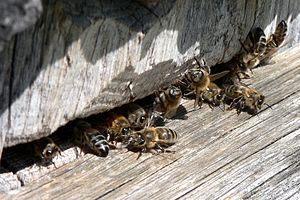
Beekeeping was traditionally practiced for the bees' honey harvest, although nowadays crop pollination service can often provide a greater part of a commercial beekeeper's income. Other hive products are pollen, royal jelly, and propolis, which are also used for nutritional and medicinal purposes, and wax which is used in candlemaking, cosmetics, wood polish, and for modelling. The modern use of hive products has changed little since ancient times.
Western honeybees are not native to the Americas. American, Australian, and New Zealand colonists imported honeybees from Europe, partly for honey and partly for their usefulness as pollinators. The first honeybee species imported were likely European dark bees. Later italian bees, carniolan honeybees and caucasian bees were added.
Western honeybees were also brought to the Primorsky Krai in Russia by Ukrainian settlers around 1850s. These Russian honey bees that are similar to the Carniolan bee were imported into the U.S. in 1990. The Russian honeybee has shown to be more resistant to the bee parasites Varroa destructor and Acarapis woodi.
Before the 1980s, most U.S. hobby beekeepers were farmers or relatives of a farmer, lived in rural areas, and kept bees with techniques passed down for generations. The arrival of tracheal mites in the 1980s and varroa mites and small hive beetles in the 1990s led to the discontinuation of the practice by most of these beekeepers as their bees could not survive among these new parasites.
In Asia, other species of Apis exist which are used by local beekeepers for honey and beeswax. Non-Apis species of honeybees, known collectively as stingless bees, have also been kept from antiquity in Australia and Central America, although these traditions are dying, and the trigonine and meliponine species used are endangered.
Art of beekeeping
The control of a colony mainly consists in taking care of the state of the “demography” of the hives. Although some call it a "science," the "art" of the beekeeper is in managing a colony's population so that the maximum number of bees is available for a task at a particular time. Most beekeepers are interested in a surplus of honey. Maximal honey production occurs when the most workers bees (both foragers and ripeners) are present at the exact same time that nectar-producing flowers (in both numbers and nectar production) are also at an optimum. For pollination, both the grower and beekeeper are looking for a surplus of foraging honey bees. Package bee and queen producers try to have as many nurse (young worker) bees as possible on hand. Queen breeders also try to manage drone population numbers.
A colony of bees is composed of a single queen, many workers (infertile females), drones (males), and a brood (eggs, larvae, and pupae). A hive is the box used by beekeepers to house a colony.
A colony of bees tries to accumulate a surplus of provisions (nectar and pollen) during the more favorable seasons (when there is a lot of forage, such as flowers available, along with good weather) in order to be able to survive the more unfavourable seasons and reproduce. This period is the winter in the Northern hemisphere; in the Southern Hemisphere and in Africa this period is the dry season, or Summer.
The population of the colony varies according to the seasons. It is important for the colony to have a large population (30,000 to 60,000+ individuals) when there is a lot of forage available, in order to achieve the greatest possible harvest. The population is minimal in the winter (6,000 individuals) in order to reduce the consumption of provisions. The colony should not be too weak, however, because the bees which overwinter have to revive the colony again in the spring. If the population is too small over winter, another problem may be encountered: honey bees need to cluster together in winter in order to maintain the temperature (9 degrees celsius) required for their survival, and with reduced populations this is much more difficult to achieve.
Types of beekeepers
There are several types of beekeepers:
- Hobbyists — They have a different day job but find beekeeping fun as just a hobby.
- Sideliners — Basically, sideliners have other income but moonlight as "beekeepers" for extra money.
- Commercial — Beekeeping is their only source of income.
Some southern U.S. and southern hemisphere (New Zealand) beekeepers keep bees primarily to raise queens and package bees for sale. In the U.S., northern beekeepers can buy early spring queens and 3- or 4-pound packages of live worker bees from the South to replenish hives that die out during the winter, although this is becoming less practical due to the spread of the africanized bee,
In cold climates commercial beekeepers have to migrate with the seasons, hauling their hives on trucks to gentler southern climates for better wintering and early spring build-up. Many make "nucs" (small starter or nucleus colonies) for sale or replenishment of their own losses during the early spring. In the U.S. some may pollinate squash or cucumbers in Florida or make early honey from citrus groves in Florida, Texas or California. The largest demand for pollination comes from the almond groves in California. As spring moves northward so do the beekeepers, to supply bees for tree fruits, blueberries, strawberries, cranberries and later vegetables. Some commercial beekeepers alternate between pollination service and honey production but usually cannot do both at the same time.
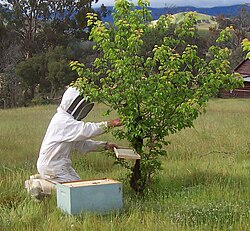
In the Northern Hemisphere, beekeepers usually harvest honey from July until September, though in warmer climates the season can be longer. The rest of the year is spent keeping the hive free of pests and disease, and ensuring that the bee colony has room in the hive to expand. Success for the hobbyist also depends on locating the apiary so bees have a good nectar source and pollen source throughout the year.
In the Southern Hemisphere, beekeeping is an all-the-year-round enterprise, although in cooler areas (to the south of Australia and New Zealand) the activity may be minimal in the winter (May to August). Consequently, the movement of commercial hives is more localised in these areas.
Types of beekeeping equipment
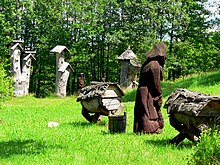
There are considerable regional variations in the type of hive in which bees are kept. A hive is a set of wooden boxes filled with frames that each hold a sheet of wax or plastic foundation. The bottom box, or brood chamber, contains the queen and most of the bees; the upper boxes, or supers, contain just honey. The bees produce wax and build honeycomb using the wax sheets as a starting point, after which they may raise brood or deposit honey and pollen in the cells of the comb. These frames can be freely manipulated and honey supers with frames full of honey can be taken and extracted for their honey crop. In the USA, the Langstroth hive is commonly used. The Langstroth was the first type of hive with movable frames, and other designs of hive have been based on it. In the UK, the most common type of hive is the National Hive but it is not unusual to see some other sorts of hive (Smith, Commercial and WBC, rarely Langstroth). The more traditional skep is now largely unlawful in the United States, as the comb and brood cannot be inspected for diseases.
A few hobby beekeepers are adopting various top-bar hives commonly found in Africa. These have no frames and the honey filled comb is not returned to the hive after extraction, as it is in the Langstroth hive. Because of this the production of honey in a top bar hive is only about 20% that of a Langstroth hive, but the initial costs and equipment requirements are far lower. Top-bar hives also offer some advantages in interacting with the bees and the amount of weight that must be lifted is greatly reduced.
Protective clothing
When interacting with the bees, novice beekeepers usually wear protective clothing (including gloves and a hooded suit or hat and veil). Experienced beekeepers rarely use gloves because they make movement clumsy and can transmit disease from one hive to another. The face and neck are the most important areas to protect, so most beekeepers will at least wear a veil.
Defensive bees are attracted to the breath and a sting on the face can lead to much more pain and swelling than a sting elsewhere while a sting on a bare hand can usually be quickly removed by fingernail scrape to reduce the amount of venom injected.
The protective clothing is generally light colored and of a smooth material. This provides the maximum differentiation from the colony's natural predators (bears, skunks, etc.) which tend to be dark-colored and furry.
Smoker
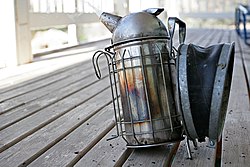
Smoke is the beekeeper's second line of defense; protective clothing provides remarkably little protection from agitated bees. Most beekeepers use a "smoker"—a device designed to generate smoke from the incomplete combustion of various fuels. Smoke calms bees; it initiates a feeding response in anticipation of possible hive abandonment due to fire. Smoke also masks alarm pheromones released by guard bees or when bees are squashed in an inspection. The ensuing confusion creates an opportunity for the beekeeper to open the hive and work without triggering a defensive reaction. In addition, when a bee consumes honey the bee's abdomen distends, making it difficult to make the necessary flexes to sting.
Smoke is of no use with a swarm, because swarms do not have honey stores to feed on in response. Usually smoke is not needed since swarms tend to be less defensive, as they have no stores to defend, and a fresh swarm will have fed well from the hive.
Many types of fuel can be used in a smoker as long as it is natural and not contaminated with harmful substances. These fuels include hessian, cardboard, and rotten or punky wood. Some beekeeping supply sources also sell commercial fuels like pulped paper and compressed cotton, or even aerosol cans of smoke.
Formation of new colonies
Swarming
- Please see the main article on swarming for more information.

The most successful colonies reproduce by swarming. In the beginning of spring, several queen cells are produced. About a week before the queens are born, the old queen leaves the hive with half of the worker bees (all categories) and they form a swarm: right when they leave, the worker bees' crops are all stuffed with supplies, and because of this, they can't sting: new swarm is harmless for several hours.
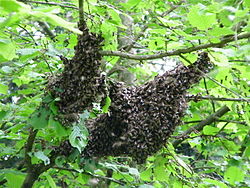
This swarm is looking for shelter; a beekeeper who captures it and introduces it into a new hive and meet this need. Otherwise, it will return to a wild state, in which case it will find shelter in a hollow tree, an excavation, an abandoned chimney or even behind shutters.
Inside the hive, the first queen to be born will immediately kill all her rivals who are still in their cells. This is due to the fact that each colony can only have one queen. One week later, the new queen undertakes her first nuptial flight.
A colony can produce, from spring to the start of summer, up to three swarms: the primary, secondary and tertiary.
Artifical swarming
When a colony acidentally loses its queen, it is said to be orphaned. The workers realize that the queen is absent after one or two days. The colony cannot survive without the queen laying eggs, renewing its population. So the workers select cells containing eggs aged less than three days and enlarge these cells. The larvae contained therein recieve nothing but royal jelly, which ensures that they will grow up to be queens.
Beekeepers use this capability in order to multiply their colonies. In order to do this, they remove several honeycomb panels of from a healthy hive. These panels must hold many worker bees and eggs aged less than three days. The workers are then placed into a little hive that has honeycombs filled with provisions. If everything goes well, a new queen is born two weeks later.
Harvesting honey
-
 A beekeeper removing frames from the hive
A beekeeper removing frames from the hive
-
 A frame
A frame
-
 Smoking the hive
Smoking the hive
-
 Opening the cells
Opening the cells
-
 A beekeeper's fork
A beekeeper's fork
-
 Uncovering the honey
Uncovering the honey
-
 Extracting the honey
Extracting the honey
-
 Filtering the honey
Filtering the honey
See also
| Honey bee types and characteristics | |
|---|---|
| Bee castes | |
| Life cycle | |
| Subspecies, Breeds and Phenotypes |
|
| Cultivation | |
| Equipment | |
| Parasites and diseases | |
| Lists | |
| Beekeeping by countries | |
| Museums and insectariums | |
External links
- Instructional Video Guide to Beekeeping Beekeeping expert shows hobbiests the ins and outs of beekeeping in free online video series.
- The American Beekeeping Federation
- The British Beekeepers' Association
- National Beekeepers Association of New Zealand
- International Bee Research Association
- The international federation of beekeepers associations, Apimondia
- Apiary Honighäuschen at the Drachenfels
- Lessons from the hive - article
- Vinlandic Apiary - A dedicated beekeeping wiki A specialized wiki aspiring to be definitive.
- Beesource Plans for beekeeping equipment, information, beekeeping forums
- Bush Bees Natural Beekeeping, Advice for Beginners, Alternatives, Huber's New Observations on the Natural History of Bees